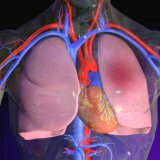Thromboembolism of the pulmonary artery: clinic, diagnosis, treatment, prevention
 PE is an abbreviation for a medical term. So called pulmonary embolism. It is a blockage in the pulmonary artery of its trunk and branches by an embolus( thrombus) that occurs suddenly. A thrombus is formed in the ventricle on the right side or in the atrium. It can also form in the vein of veins of a large circle of blood flow. A thrombus is brought with a blood stream. As a result of blockage, blood ceases to flow to the lung tissue. Thromboembolism of the pulmonary artery, clinic, diagnosis, treatment, prevention of which are described below - a very serious disease. As a result of a rapidly developing illness, death may occur.
PE is an abbreviation for a medical term. So called pulmonary embolism. It is a blockage in the pulmonary artery of its trunk and branches by an embolus( thrombus) that occurs suddenly. A thrombus is formed in the ventricle on the right side or in the atrium. It can also form in the vein of veins of a large circle of blood flow. A thrombus is brought with a blood stream. As a result of blockage, blood ceases to flow to the lung tissue. Thromboembolism of the pulmonary artery, clinic, diagnosis, treatment, prevention of which are described below - a very serious disease. As a result of a rapidly developing illness, death may occur.
PE: causes
most common causes of the disease may be:
- thrombosis tributaries and most inferior vena cava;
- is a generalized process that has a septic character;
- cardiovascular diseases which are conducive to the formation of emboli and thrombi in vessels including the pulmonary arteries, such as coronary heart disease, rheumatic disease in its active phase with mitral stenosis, atrial fibrillation, hypertension, endocarditis infectious etiology, cardiomyopathy, myocarditis, rheumatic plan);
- is an oncological disease( for example, lung, stomach, pancreas cancer);
- DVT( deep vein thrombosis) located in the lower leg, it is often accompanied by thrombophlebitis;Vein thrombosis( superficial and deep) often develops;
- thrombophilia, i.e. intravascular thrombus that occurs in disorders in the hemostatic system);
- antiphospholipid syndrome when antibodies are formed to platelet phospholipids, nerve and endothelial cells.
Pulmonary embolism : Clinic
Zabolevvanie happens:
- lightning speed( acute).In this case, the thrombus immediately and completely clogs the main artery trunk and both its branches. Immediately stops breathing, there is a collapse and fibrillation of the ventricles. Death can come in minutes.
- Sharp. In this case, the obturation of the branches of the artery rapidly increases. The attack comes unexpectedly, the symptoms quickly progress. Cardiac, respiratory and cerebral insufficiency develops. The process can last up to 5 days, there may be complications in the form of a pulmonary infarction.
- Prolonged( subacute).In this case, a thrombosis is formed in the middle and large branches of the pulmonary artery and multiple pulmonary infarction occurs. The process lasts for several weeks. It progresses rather slowly and is accompanied by right ventricular and respiratory insufficiency. Often there are secondary thromboembolisms, and the symptoms in this case are more acute. Often the attack ends with death.
- Recurrent( chronic).In this case, recurrent thrombosis of the lobar artery branches appears. There may develop repeated pulmonary infarctions and pleurisy, which are often bilateral. Gradually, hypertension of the small circle of blood flow increases and right ventricular failure develops. This happens, as a rule, after operations in the presence of oncological diseases and pathologies of the heart and blood vessels.
Thromboembolism : diagnostics
When the diagnosis is to identify the main blood clots in the vessels of the lungs location and evaluation of the extent of their losses. At the same time, in order to prevent relapses, it is still necessary to identify the main cause of thromboembolism.
To diagnose PE is very difficult, therefore patients should be in a hospital under the supervision of a doctor. Those suspected of developing PE are examined as follows:
- collect medical history, assess the degree of pulmonary embolism or DVT, clinical symptoms,
- Make biochemical and general urine and blood samples, examine blood gases, D-dimer in plasma( diagnosis of venous blood clots), coagulation,
- In order to avoid a heart attackMyocardium, heart failure and pericarditis, ECG( in dynamics),
- In order to exclude pneumothorax, primary pneumonia, tumors, pleurisy and fracture of ribs, chest radiography is performed,
- ennoe blood pressure in the pulmonary artery, the presence of thrombosis in cardiac cavities and overload in the right parts of the heart muscle, do echocardiography,
- If you compromised perfusion of blood through the lung tissue, it means that due to pulmonary embolism reduced blood flow, or none at all, why spend scintigraphyLungs,
- To determine the size of the thrombus and its location, do angiopulmonography, and to identify the cause of thromboembolism, make contrast phlebography and ultrasound of veins( peripheral).
Thromboembolism of the pulmonary artery : treatment of
Those who are suspected of developing PE are placed in the hospital in intensive care.
If the patient's condition is urgent, then carry out all activities of the resuscitation plan.
The subsequent treatment of the disease aims to normalize the pulmonary circulation in order to prevent the development of a chronic form of hypertension in the lungs.
We must comply with strict bed rest. In order to reduce the viscosity of blood and maintain blood pressure, massive infusion therapy is performed.
At the initial stage, thrombolytic therapy is prescribed to dissolve the thrombus as quickly as possible and restore blood flow. Then, in order to prevent recurrence of pulmonary embolism, heparin therapy is carried out. If there is an infarct-pneumonia, prescribe antibacterial therapy.
In the development of massive PE, and in the event that thrombolysis is ineffective, a surgical thromboembollectomy is performed, that is, the thrombus is removed. As an alternative to embobectomy, the method of catheter fragmentation of thromboembolis is performed.
PE: relapse
For the prevention of PE in the inferior vena cava put a special filter.
If the patient has been assisted in time and all the necessary medical measures are carried out, then the forecast is favorable. If the cardiovascular and respiratory disorders are expressed against the background of PE, then in these cases the lethality is higher than the 30% level.
More than half of the recurrences of the disease occur in those who did not receive anticoagulants. If anticoagulant therapy was performed correctly and on time, the risk of relapse is reduced by half. To prevent the development of thromboembolism, it is necessary to diagnose and start treatment of thrombophlebitis in time.
PE: prevention
It is timely to expand the bed rest after surgery, diagnose and treat developing thrombophlebitis leg. Those who suffer from heart failure, obesity, those who have discovered the malignant tumor and underwent surgery on the organs in the pelvis and retroperitoneal space, as well as those who are on the immobilization, must take place in order to prevent the introduction of low molecular weight heparin plan. If thromboembolism has the properties to give relapses, it is necessary to put the filter in a vein.



